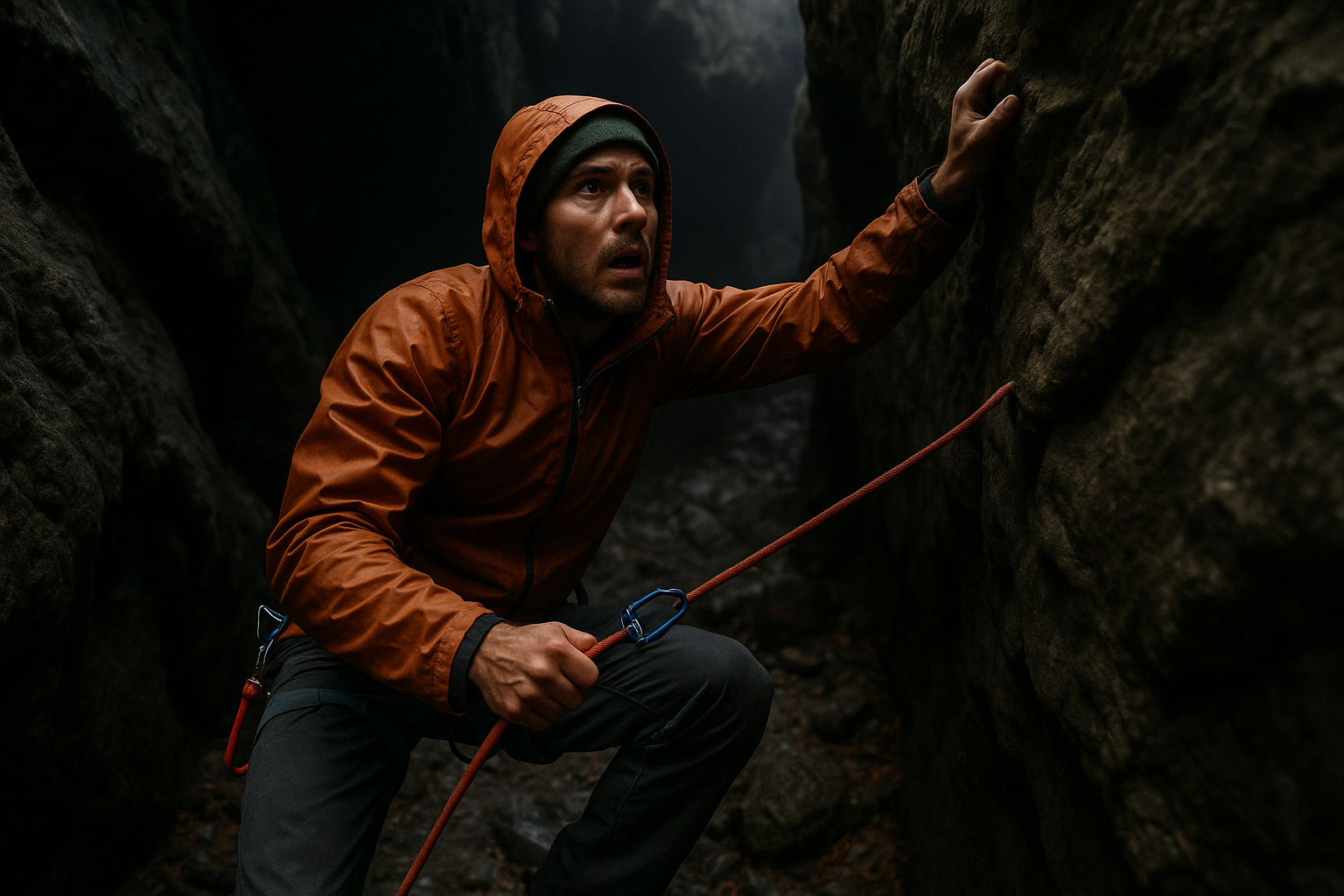The Sun’s Dropping—and You’re Stuck
You’ve been following a narrow trail, and a loose edge gave way. Now you’re at the bottom of a steep ravine, walls rising on all sides, the sun slipping below the horizon. Cell service is dead, and waiting isn’t an option.
In this critical situation, your survival depends on compact, field-ready climbing gear and improvised self-rescue tactics that you can deploy with minimal equipment. This isn’t mountaineering—it’s tactical self-preservation.
1️⃣ Lightweight, Packable Climbing Rope
You don’t need a full rope kit—just a compact, high-strength cord that packs down small but can support your weight.
- Sterling Nano 9.2mm Dry Climbing Rope (Amazon): Lightweight, water-resistant, and strong enough for emergency self-rescue.
- Beal Rando Dry Rope (Amazon): 8mm, ultralight, and perfect for short, steep climbs or assisted ascents.
- Paracord Backup: While not ideal for full-weight climbing, 550 paracord can assist in building anchors, friction knots, or stabilizing gear.
💡 Pro Tip: Practice basic knots like the prusik, klemheist, and munter hitch beforehand—knots can save your life.
2️⃣ Compact Ascenders and Pulleys
Getting up steep walls requires mechanical advantage. Choose:
- Petzl Tibloc (Amazon): Ultra-compact ascender that grabs rope under load. Clip to a locking carabiner and use as a progress-capture device.
- Wild Country Ropeman 1 Ascender (Amazon): Compact and lightweight, grips ropes tightly and works with most cord diameters.
- Micro Pulleys (like Petzl Partner): Combine with an ascender and carabiner for a basic hauling system if you’re carrying gear or injured.
🧗 Tactical Insight: Carry at least one ascender and a few locking carabiners for creating friction systems.
3️⃣ Improvised Anchors with Minimal Gear
If natural anchors (trees, boulders) are absent, you’ll need to create your own:
- Nuts and Hexes (like Black Diamond Stopper Set, Amazon): Lightweight metal wedges that secure in rock cracks.
- Slings and Webbing: Ultralight, strong, and multipurpose. Can be girth-hitched around rock formations, logs, or even your pack filled with debris.
- Backpack Anchor Hack: In dire need, load your pack with rocks or soil and use it as a counterweight anchor.
🎒 Field Wisdom: Always check anchors by testing load with body weight before committing.
4️⃣ Ultra-Compact Harness Alternatives
A full harness may be too bulky, but you can carry:
- Edelrid Fraggle II Kids Harness (Amazon): Surprisingly compact and adaptable to slim adults in emergencies.
- DIY Harness: Improvise with strong webbing or tubular nylon tied into a Swiss seat (a classic emergency harness technique).
- Climbing Slings: Can be configured into leg loops and waist belts for basic support.
🔥 Critical Note: A poorly tied harness can be fatal. Practice tying and testing a Swiss seat before trekking.
5️⃣ Emergency Foot Loops and Aiders
Gain vertical movement with:
- Petzl Looping Aider (Amazon): Compact, 5-step webbing ladder that helps you ascend rope or step over obstacles.
- DIY Foot Loop: Tie a loop in webbing or cord to create an improvised stirrup for climbing.
- Use Trekking Poles for Leverage: Secure poles horizontally between cracks or logs to create step points.
🌲 Pro Hack: Use natural formations—branches, exposed roots, or embedded rocks—as impromptu steps.
6️⃣ Stealth and Low-Profile Gear Considerations
If your scenario involves stealth (avoiding human threats, wildlife, or searchers):
- Matte-Finish Gear: Avoid shiny carabiners, reflective rope, or bright harnesses. Opt for black or earth tones.
- Silent Movement: Practice clipping and ascending quietly. Avoid dropping gear or clattering metal.
- Compact Stowage: Carry gear in a low-profile pouch or hip belt, ready for rapid deployment.
🌑 Field Move: In low light, use a red headlamp aimed down to maintain night vision and avoid drawing attention.
7️⃣ Essential Backup Tools
- Friction Devices (like Petzl Reverso or Black Diamond ATC): For rappelling or controlled descent if needed.
- Knife or Multi-Tool (like Leatherman Signal, Amazon): Cut rope, build anchors, or create makeshift steps.
- Gloves: Protect hands from rope burn or sharp rock edges during climbs.
🧤 Field Trick: If gloves are missing, wrap hands with cloth, duct tape, or strips of clothing for protection.
8️⃣ Improvised Techniques if Gear Fails or Missing
- Natural Holds: Look for cracks, ledges, tree roots—use hands and feet to inch upward.
- Counterweight System: If you have a partner, rig a simple haul system using your weight and an improvised pulley (like a carabiner over a branch).
- Prusik Loops with Paracord: Tie friction knots on your rope to climb up incrementally.
🔥 Caution: Never rush—each move must be deliberate. Test every hold and anchor before committing your weight.
Field-Ready Gear Recommendations (Amazon)
- Sterling Nano 9.2mm Dry Rope – Lightweight, dry-treated rope for emergencies.
- Petzl Tibloc Ascender – Compact rope grab for vertical ascents.
- Sea to Summit Ultra-Sil Dry Sack – Compact dry bag for organizing rescue gear.
- Black Diamond Stopper Set – Secure metal nuts for creating solid anchors.
Real-World Trekker Story
“On a solo canyon hike, I slipped into a ravine with sheer sides. My lightweight rope, ascender, and a makeshift Swiss seat were the only things that got me out before dark. Now, I never trek without a minimal self-rescue kit.”
Conclusion: Climb Smart, Climb Now
When trapped in a ravine during a day-trek, waiting isn’t an option. The right compact climbing gear, tactical improvisation, and practiced skills can get you back to safety before darkness falls. Equip your kit with these essentials and train for the unexpected.
In survival, hesitation kills. Pack light, climb smart, and escape when you can.

